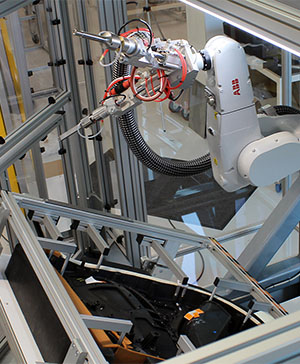
Flexible Plastic Welding And Cutting Using Robot-Mounted Ultrasonics
Telsonic UK’s Martin Frost highlights important technical aspects that engineers should consider when using robot-mounted ultrasonic technology for plastics welding and cutting operations.
There is currently a strong focus on robotics within UK manufacturing, as many companies strive to implement automation to help improve flexibility, productivity and quality. The UK’s automotive plants have always been a shining example of how robots can be used successfully, and today increasing numbers of robots are being installed within a growing number of automotive Tier 1 and Tier 2 suppliers.
While the majority of robots within the OEM plants are involved predominately with welding and sealing on the body in white components, the applications within the Tier level companies are much more diverse, a testament to the flexibility of the technology and the innovative thinking of the engineers employed by these companies.
Increasing flexibility through automation
Flexibility is becoming ever more important in today’s automotive manufacturing facilities as the variation of vehicles based on a principle platform, and the number of options available to a customer when purchasing their vehicle continues to expand. This means that the manufacturing process for both interior and exterior components must be cable of rapid changeover between part variants to ensure the highest levels of productivity.

This drive towards increasing personalisation and the resultant need for more flexibility have been key factors in the decision by many tier level plastics companies to introduce robot mounted ultrasonic technology for both welding and cutting processes.
It is easy to see why these two technologies have become natural partners. The dexterity of 6-axis robot within its wide operating envelope, and the ability to handle significant payloads if required, combined with the compact nature of ultrasonic technology, the ease with which it can be mounted to a robot arm, and the capability to both precisely control the process and acquire statistical data.
Telsonic’s Martin Frost explains where this combination of technologies is already being used successfully: “There are a wide range of automotive components that require post moulding processing in the form of welding or cutting. Typically these include both internal and external components such as wheel arch liners, door trim panels, centre console assemblies, door pillar mouldings, load space mouldings, roof liners, fuel tanks, bumper assemblies and engine under-trays to name but a few.” Frost continues: “Our ultrasonic technology is being used to swage or stake tabs, to secure componentry to a substrate, spot weld materials such as NVH, assemble clips to plastic fuel tanks and also cut and trim fabric wrapped interior components.”
Robot or Multi-Head Special Purpose Machine? – It’s a numbers game
There are, however, several points to be considered when thinking about using ultrasonic technology in conjunction with a robot. These fall into the main categories of cycle time and weld process management. The number of weld or staking points required in any given application, and the available cycle time, can have a significant influence on the decision on whether to use a robot or a dedicated multi-head machine.

Where there are large numbers of weld or staking points, a single part type and a relatively short cycle time, then a multi-head machine is most likely to be the optimum solution. However, if there are several part variants that need to be processed within the same system, and higher levels of flexibility are required, then the robot solution begins to look more attractive. Also, as the relative cost of standard 6-axis robots continues to fall in real terms, a dual robot solution, or a single robot with dual ultrasonic heads, may become a more cost-effective option when compared to the design and development of a complicated multi-head machine for multiple part types.
Those considering the combination of ultrasonic welding technology and a robot must also take into account a number of factors. There are several options relating to how much ultrasonic equipment is mounted to the robot arm, and this may be determined to some extent on the size and payload capacity of the robot.
The lightest configuration comprises of mounting the ultrasonic converter, booster and sonotrode, and using the robot arm to provide the force needed to produce the weld, as opposed to having an on-board actuator. Although a weight saving concept, precision robot programming is required to take account of the melt rate of the material and achieve a consistent weld collapse profile.
The influence of force applied by the robot when producing a weld is also something that requires consideration. For swaging, staking or spot welding the amplitude of the ultrasonic system influences the force required. Initially a higher force at the point of contact, this then naturally reduces as the material reaches melt point and begins to form a melt pool. However, if the rate of the weld is fast enough, maintained through robot velocity, the force will be maintained.
Alternatively, one of Telsonic’s AC series of actuators, which offer a wide range of force and power options, can be mounted to the robot arm. In this scenario, the robot is used solely to position the actuator at the various weld points, and the actuator uses fine pressure regulation to act as a pneumatic spring.

In certain cases, system integrators have been known to design their own pneumatically compliant solutions. Again, the pneumatic configuration serves to operate as a spring, allowing the robot to over-travel with the resultant pneumatic pressure being used to produce the weld feature as the material melts. Switches on the actuator are used to start and stop the ultrasonic pulse. Another weight-saving concept is to omit the booster and mount the sonotrode directly to the converter, with the converter designed to be mounted directly to the robot face-plate or actuator.
Another consideration is that of the weld point feature. This is especially important if a single sonotrode is to be used, where it is essential that the size and volume of the weld pins or tabs need to be similar in configuration. Subtle changes in the weld pin or tab can sometimes be accommodated by automatically selecting different welding parameters as the robot moves around the part, however, if there are significant differences, such as a combination of hollow pins and tabs, then automatic tool changing or a dual sonotrode head may be the optimum solution. To ensure the most efficient outcome, early discussions and collaboration between the product designer and the supplier of the ultrasonic equipment will ensure that joint design features, material volume to be displaced and other important criteria can be evaluated and specified.
Process heat management – Keeping things cool

A major topic in robot ultrasonic welding and cutting is process heat management. Ambient air-cooled converters & chilled air-cooled tooling are mandatory in fast multi-point welded part cycles. This is especially important for materials and parts that require high ultrasonic amplitude and repetitive immersion of the tool in the melt pool. These measures serve to control the ultrasonic converter temperature and prevent stringing of the molten polymer as the tool leaves the welding point. The cooling must be efficient, preferably around and through the tool via cooling channels, and on full wavelength tools used on booster-less mounts, to control the heat-conducting up towards the converter. To address these requirements, Telsonic has developed a patent-pending vortex booster. This is an integrated design that sits between the converter and the tool, pre-cooling compressed dry air which in turn assists the cooling process, keeping the tool cool, especially during the hold stage of the process.
Cutting things fine
The flexibility of the ultrasonic process has seen this technology adopted by several plastics manufacturers for cutting and trimming applications. These are generally in areas where a plastic substrate is covered with a fabric material, as seen on automotive A, B & C Pillars and Roof Linings etc.
Key points for engineers to appraise when considering using ultrasonics in conjunction with a robot for cutting applications include: establishing the maximum linear speed that the robot head can travel, by conducting material cutting trials. These trials will also establish the minimum turning radius that the ultrasonic blade allows, and indeed if the material will cut effectively and provide a superior cut edge when compared to mechanical blades.
These applications are normally continuous processes with continuous “ultrasonic on” times using thin-section blades, so chilled tool cooling and ambient converter cooling are mandatory. Cutting forces are usually low, if the material cuts effectively, but the force being applied to the thin tool shanks at the selected cutting speed should also be taken into consideration.
More information on Telsonic ultrasonic systems for plastic welding and cutting can be found HERE.
Telsonic Ultrasonics
+44 (0)1202 697340
Website
Email






